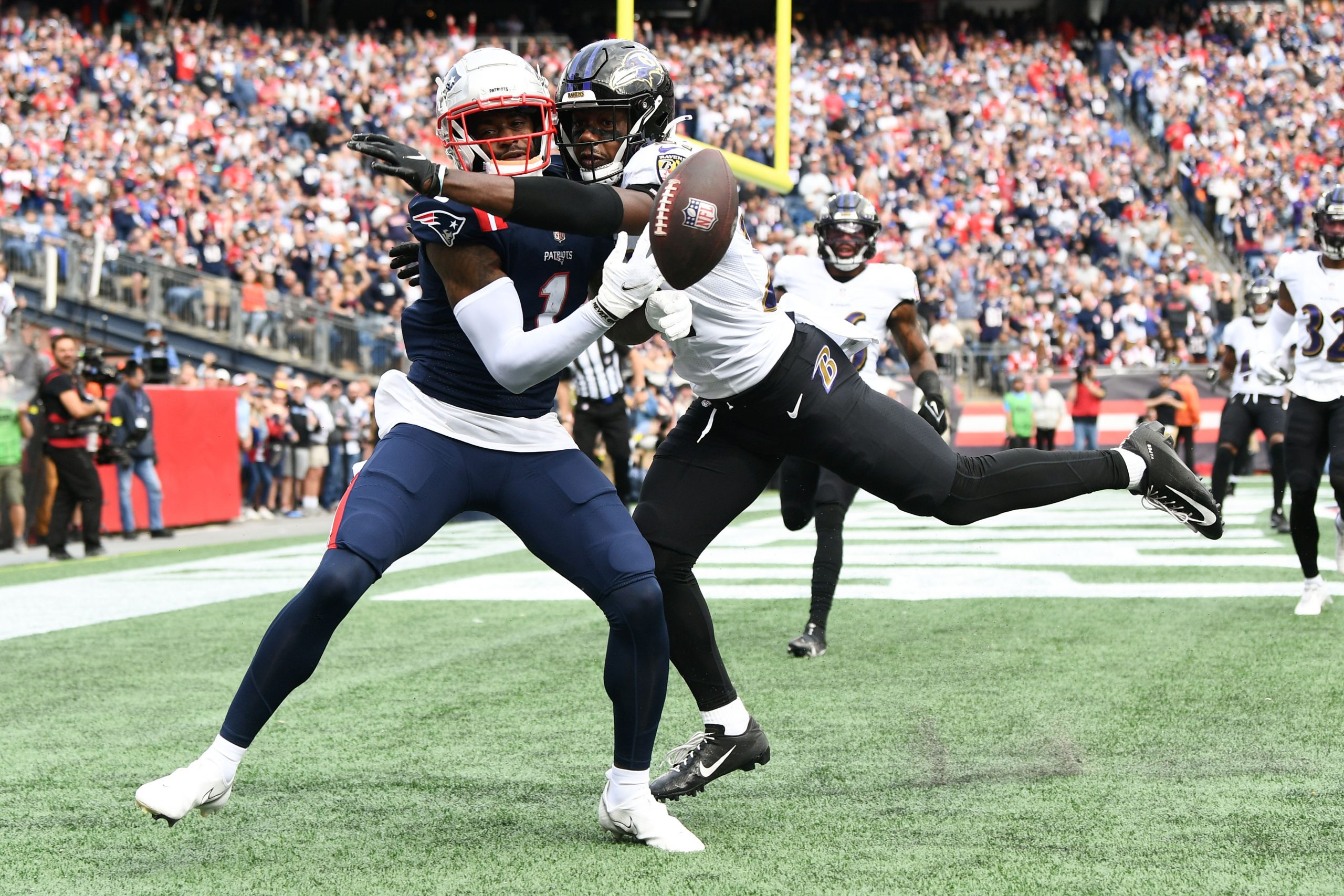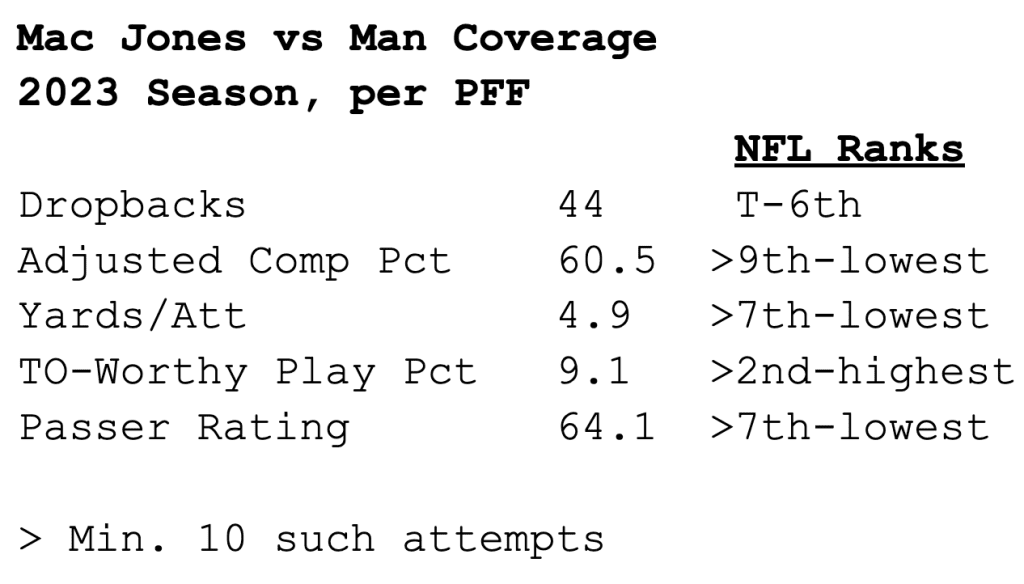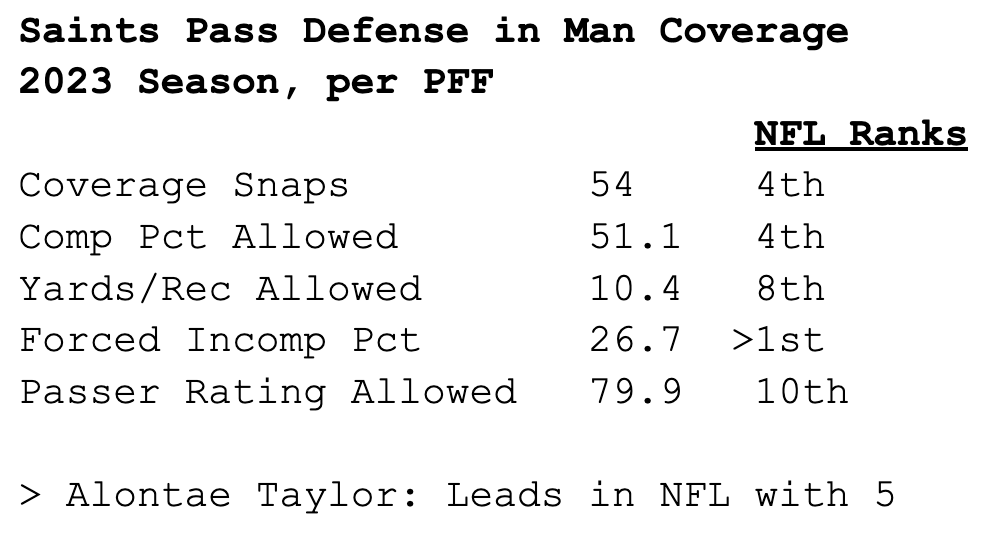

Sep 25, 2022; Foxborough, Massachusetts, USA; Baltimore Ravens cornerback Brandon Stephens (21) breaks up a pass intended for New England Patriots wide receiver DeVante Parker (1) during the first half at Gillette Stadium. Mandatory Credit: Brian Fluharty-USA TODAY Sports
Mac Jones and the Patriots’ passing attack are struggling against man coverage this season, with Jones ranking bottom-10 against such defenses by multiple metrics.


Jones went 6-10 against the Cowboys’ man coverage in Week 4, averaging just 5.4 yards per attempt and throwing an interception, though he also got away with hitting Jayvon Kearse in the hands on a scramble.
These numbers don’t bode well with the Saints coming to town, as their defense is one of the best man coverage units in the league.


But, as is usually the case, one player is never to blame for such ineffectiveness. The Patriots’ pass protection has been shaky at best and unacceptable at worst, allowing the league’s 5th-highest pressure rate at 39.6%.
The numbers haven’t been kind to Jones’ receivers, either, as the group is once again under scrutiny for struggles creating separation.
Receiver separation, while imperfect, can be a helpful snapshot of how often a quarterback is throwing into tight windows. But Patriots receivers coach Troy Brown isn’t a fan of the metric, saying over the summer, “When I came into the league, it was two things: Get open and catch the ball. So that’s all that really matters to me. If you can do those things, I don’t really keep up with the rest of it.”
Separation and openness seem like the same thing, but there’s an important distinction in the NFL. If a receiver can consistently make catches with defenders draped on him, he’s virtually always open. There are nuances to this skill, like positioning, body control, timing, etc., but the idea is you don’t always need separation to be “open.” Anticipation from a quarterback and chemistry with a receiver are also tools to defeat tight coverage.
Still, throwing into tight windows, while common in the pros, shouldn’t be an every-snap occurrence. In today’s game, top offensive coordinators are adept at using formations, alignment, and motion to take that stress off of receivers. So while the Patriots’ receiving corps lacks explosive talent, it shouldn’t be such an ineffective group with Bill O’Brien at the helm. So how much of the responsibility falls to the offensive coordinator, how much falls to Mac Jones, and how much falls to his supporting cast?
I dove into Week 4’s film to see how the Patriots’ offense attacked the Cowboys’ man coverage, why they struggled, and whether there were more positives than the stats reflect.
Tight-End Takeover
New England’s plan against Dallas revolved heavily around Hunter Henry and Mike Gesicki getting involved downfield, which made a lot of sense. Henry has been their best pass-catcher, and Gesicki has been woefully underutilized as a pass-catcher (13 targets, 10 catches, 98 yards, five 1st downs this season).
Two of these plays were designed for Henry from under-center looks, with the first being a crossing route from 11 personnel.
Henry has separation against Jourdan Lewis, but the corner’s inside help takes away Mac Jones’ initial throwing window. Jones feels the rush and steps up, but rather than anticipating the second window, he unsuccessfully flicks a checkdown to Rhamondre Stevenson. You could also argue Demario Douglas should’ve been targeted on the backside wheel route against safety Jayvon Kearse, but given the route spacing, I’m not sure if he was a viable option.
Henry’s next play-action target was a great example of what makes him such a reliable target.
The Patriots try to get the Cowboys in a heavier defense by deploying three tight ends and going under center. But with New England down 25 points in the 2nd half, Dallas wisely counters with a three-safety or “big” nickel grouping. Kearse lines up in press coverage against an in-line Henry, who bursts off the line and dips under a jam to take control of the route. Kearse jostles the tight end and ultimately draws a flag, but Henry manages to swipe free and makes a diving, one-handed catch through contact. Jones drops this one in the bucket from one of the cleanest pockets he’d have all game.
There were also plays where tight ends motioned into a stack/bunch to influence free releases.
Two were 3rd downs thwarted by pass rush and “robber” coverages with a safety dropping to eliminate crossers, though Jones seemed to miss opportunities over the middle on both. The one time this strategy worked for the tight ends took place on a 3rd & 5 with two minutes left in the 1st half.
The Patriots go empty from a two-tight end set with Ezekiel Elliott out wide. Elliott shifts from to the backfield with inebacker Markquese Bell trailing to reveal single-high man coverage. Henry then shifts into the slot beside Kendrick Bourne, followed by safety Donovan Wilson. The tight-end releases toward the sideline, making it easier for Bourne to pick off Wilson, then breaks inside. Wilson recovers well and tries to slow Henry down, but the tight end uses that contact to get open and snatches the pass to convert.
While most of the action understandably went to Henry, Mike Gesicki was a bigger part of the plan than you’d expect from his two targets against man, only one of which PFF deemed uncatchable. But both targets traveled 10+ air yards, matching Gesicki’s season total, and his one reception helped explain that uptick.
The Patriots come out in a 2×2 spread look with Gesicki and Henry in each slot. Elliott feigns a shift to the perimeter pre-snap, forcing linebacker Damone Clark to tip his man coverage. Gesicki throws Kearse a couple of head fakes to win on the crosser, and with Dallas blitzing, the safety has no inside help. Jones gets pressure at his feet with Micah Parsons quickly beating David Andrews, but he delivers a perfect throw despite poor footwork, which Gesicki attacks to make a contested catch.
Hunter Henry and Mike Gesicki combined for three targets and two catches against man entering Week 4, with each grabbing a deep out to convert 3rd downs in New York. Against the Cowboys, the duo combined to catch all four of their catchable targets against man for 49 yards and three 1st downs. So if last week was any indication, we’ll be seeing more of this strategy against New Orleans. But New England’s pass protection has to be more consistent, and more importantly, Mac Jones will need to regain the poise he displayed from Weeks 1-3 to capitalize on opportunities.
Demario Douglas Popping Up
Demario Douglas’ two catches in Dallas were against zone coverage, but there seemed to be a pair of plays where he was the primary target against man. They were disrupted by pressure, though Jones left the pocket prematurely on his rep, but both could’ve gone for big 3rd down gains.
Douglas was only targeted on one of those reps, which was the exact same play that led to his benching against the Dolphins, but with a different shift.
Hopefully, we see the rookie’s dynamic ability maximized with motion and stack/bunch looks more often moving forward. These could make Douglas’ twitchy route-running even tougher to keep up with, while more touches over the middle could help him turn modest catches into huge gains.
I explained in my deep dive how the rookie’s role could be increasing, and seeing him earn looks for the second week in a row, particularly against man coverage, is a promising sign. There will be growing pains, as even Douglas’ 42-yard reception early last week featured an error that led to the initial play breaking down. This could explain why O’Brien opted to scheme around his proven veterans at tight end, but the explosive potential he brings may be worth the risk.
Week 5 Outlook
The Saints’ defense is too talented and too well-coached to expect a big-time bounce-back for Mac Jones and company, but that doesn’t mean all hope is lost. First and foremost, the offense needs to play clean football free of turnovers and sloppy penalties. And while protection needs to hold up its end of the deal, Jones can’t exacerbate problems by overreacting to pressure and letting his internal clock run wild.
Bill O’Brien did a solid job using motion and formations to create easier opportunities for his receivers, which bodes well against a New Orleans secondary that excels in straight 1-on-1 matchups. But there were also plays that needed to be cleaned up, like poor route spacing and botched rub concepts.
Leaning on the tight ends again is probably the wisest path this week, but getting Demario Douglas and even Kendrick Bourne manufactured targets underneath could take some pressure off of New England’s struggling downfield pass game. Regardless of which players are featured, the offense will need its best performance of the season with urgency at an all-time high.
BOSTON - The Celtics dominated the Knicks on Sunday afternoon in a 118-105 victory. Boston…
The Boston Celtics secured a 118-105 victory over the New York Knicks on Sunday, continuing…
BOSTON -- The Boston Celtics secured a 118-105 victory over the New York Knicks on…
Jayson Tatum nearly recorded a triple-double, finishing with 25 points, 10 rebounds, and 9 assists,…
BOSTON -- The Celtics normally probe to find mismatches, shuffling through screens before making their…
Pucks with Haggs host Joe Haggerty answers Bruins fans' questions coming out of the 4…